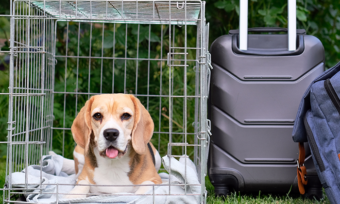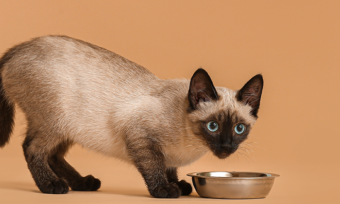What’s the link between obesity and pet diabetes?
A recent estimate from veterinarian supplier Animates classifies over 40% of dogs and 30% of cats in New Zealand as obese. It’s clear that pet weight gain is on the rise. Owners need to be vigilant.
While a chubby pet might make for some cute Instagram photos, carrying extra weight comes with serious consequence for your animals.
For example, the risk for diabetes in cats increases by four times when your cat is classed as obese. (Find out about average cat weight if you’re not sure where your cat falls.) And if that wasn’t enough motivation to keep the weight off your pet, obesity often also brings with it many related conditions.
Signs of diabetes in animals
It’s important that pet owners are vigilant about their animals’ health. Keep an eye out for any warning signs that something might not be quite right. Sometimes it can be hard to tell if your dog or cat might be diabetic, as the signs of diabetes in pets are often quite general. They can go unnoticed or be misdiagnosed.
When it comes to the signs of diabetes in dogs and cats, what to look out for includes:
1. Increased thirst
If your pet is suddenly drinking a lot more water than usual, it could be a sign. Take notice how often you refill their water bowls.
2. Frequent urination
If your dog or cat starts needing to pee a lot more often, especially at night, that’s a common symptom.
3. Weight changes
A significant change in weight, whether they’re losing weight despite a good appetite or gaining weight, can be a red flag.
4. Increased appetite
Sometimes, diabetic pets will act super hungry even if they’re losing weight. This is due to their body’s inability to absorb nutrients.
5. Lethargy
If your usually energetic pet becomes lethargic and seems less interested in playing or going for walks, that’s another potential sign.
6. Cloudy eyes
For dogs, cataracts (cloudy eyes) can sometimes develop quickly.
7. Unpleasant breath
Diabetes can lead to a sweet, fruity odour on your pet’s breath.
8. Chronic or recurring infections
This includes skin infections (read about dog skin conditions) and urinary infections (read about UTIs in cats).
If you notice any of these symptoms of diabetes in your pet, be sure to visit a vet immediately and voice your concerns. Your prompt action could save your pet’s life!
How do animals get diabetes?
Diabetes in dogs and cats isn’t too different from diabetes in people. It’s basically when their bodies have trouble managing sugar, or glucose. Here’s how it happens:
Type one diabetes (insulin dependent)
This is kind of like what people call “juvenile diabetes”. It usually happens when a dog or cat’s immune system goes a little haywire and starts attacking the cells that make insulin, a hormone that helps control blood sugar.
Without insulin, their bodies can’t use sugar for energy, and it builds up in the blood.
Type two diabetes (non-insulin dependent)
This is more common in cats. In Type 2, their bodies still make insulin, but it’s not working as well as it should. The cells aren’t responding properly, so sugar can’t get into them.
As for why it happens, there isn’t always a clear cause. But things like genetics, obesity, and sometimes other health issues can increase the risk. It’s kind of like a puzzle, and all the pieces are a bit different for each pet.
Managing diabetes in pets
Early detection and swift treatment of diabetes in dogs and cats is key to giving your pet the best quality of life. Just like with people, good medical care and lifestyle management means that diabetic pets can still lead long and healthy lives with careful monitoring and awareness.
The goal of diabetes treatment in pets is to keep blood glucose levels normal and stable. This will typically mean that owners need to feed their pets a specific diet, conduct regular testing on blood glucose levels, and monitor for any changes in symptoms.
Diabetes in dogs and cats alike usually requires treatment with daily insulin injections. However, there may be some rare exceptions where this is not needed.
How can I help my pet avoid diabetes?
The phrase ‘prevention is better than cure’ definitely applies when it comes to diabetes in cats and dogs. It’s completely true that obesity is not the only factor at play when it comes to pet diabetes, and not all cases can be avoided by lifestyle management.
However, you can manage your pets’ risk of developing diabetes by taking their health and weight seriously.
Consult a vet
Ask your veterinarian what and how much you should be feeding your pet, and stick to this at mealtimes. If your pet begins to lose or gain weight on their current diet, you can adjust it within reason.
Don’t give in to the puppy dog eyes or pitiful meows with another handful of kibble if your pet is a healthy weight! Make sure to account for any scraps or treats when you’re feeding your pet too (or when others in your household are sneaking them in), as these can often be high in calories.
In addition to managing food, increasing exercise can also help to improve your pet’s overall health and weight. With dogs, this might take the form of more walks, runs, or games of fetch.
Cat people will know that their feline friends can be harder to motivate than dogs. However, anything that encourages them to move more can really reap benefits. Do you have an indoor cat? Consider building them a catio.
Related article: All About the Catio: Keeping Cats Safe
How much does it cost to treat diabetes in pets?
The cost of treating a cat or dog with diabetes can vary widely depending on several factors, including the severity of the condition, the region where you live, and the specific treatment plan recommended by your veterinarian.
Here are some general cost considerations:
1. Diagnosis
Initially, diagnosing diabetes involves blood tests and potentially urine tests. The cost for these tests can vary but is usually a few hundred dollars.
2. Insulin and supplies
The ongoing cost of insulin, syringes or insulin pens, and other supplies necessary for administering insulin will be a regular expense. The price of insulin can range from $80 to $130 or more per vial, and syringes or pens cost a few dollars.
If you need to invest in a blood glucose meter for at-home monitoring, it can cost around $100 or more.
Some diabetic pets may require additional medications or supplements, which can vary in cost.
3. Prescription food
Special diabetic pet food can be more expensive than regular cat or dog food, but prices vary by brand and type.
4. Vet visits
Regular check-ups and monitoring visits are essential. The cost of these visits will depend on your vet’s fees and the frequency of visits required.
5. Complications
If your pet experiences complications related to diabetes, such as eye infections or cataracts, additional treatments or surgeries may be necessary and can significantly increase costs.
Pet insurance
As you now know, the costs of treating a pet with dog or cat diabetes can be significant. Getting pet insurance for your dog or cat before any diabetes warning signs appear is important. That way it’s not a pre-existing condition when you take out insurance, which means you won’t be covered for it. Then you can easily get them the treatment they deserve, up to the relevant benefit limit.
Compare pet insurance providers here!
About the reviewer of this page
This report was reviewed by Canstar Content Producer, Caitlin Bingham. Caitlin is an experienced writer whose passion for creativity led her to study communication and journalism. She began her career freelancing as a content writer, before joining the Canstar team.
Enjoy reading this article?
You can like us on Facebook and get social, or sign up to receive more news like this straight to your inbox.
By subscribing you agree to the Canstar Privacy Policy








Share this article